Nuevo "Backcountry": Área de "juego no estructurado" abre el lunes 6 de junio en el Jardín Botánico de Santa Bárbara
Jardín interactivo de 4,5 acres diseñado para conectar a los niños (y a los jóvenes de corazón) con la naturaleza en un entorno seguro y hermoso
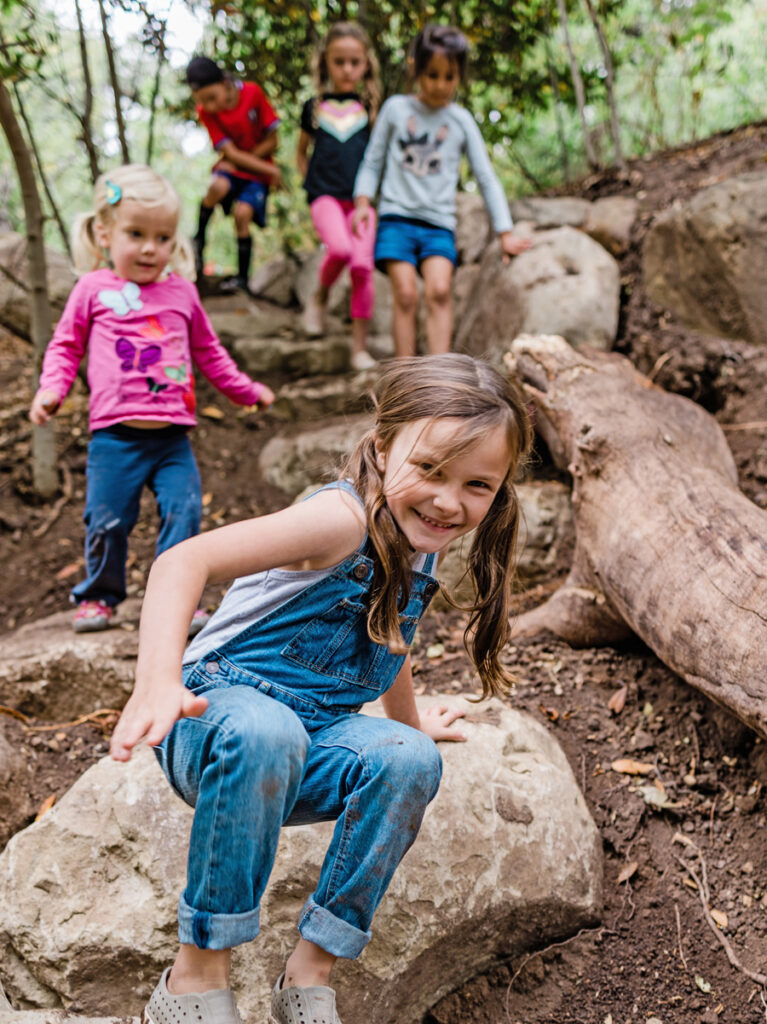
Santa Bárbara, California - 31 de mayo de 2022 - Se anima a los niños (y a los jóvenes de corazón) a explorar la naturaleza y a disfrutar del "juego no estructurado" en la nueva zona de juegos Backcountry del Jardín Botánico de Santa Bárbara, que se abre al público el lunes 6 de junio. Sesión fotográfica de Backcountry para los medios de comunicación: Lunes, 6 de junio, de 10 a 12 horas. Póngase en contacto con Julia McHugh en julia@juliapr.com para confirmar su asistencia. Fotos de alta resolución y pies de foto: https://bit.ly/3GFQR9W.
El jardín de 4,5 acres se ha diseñado especialmente para que todos los visitantes, pero sobre todo los de 5 a 13 años, puedan jugar con la naturaleza: subirse a los árboles caídos, saltar en las rocas, construir fortalezas con materiales naturales, descubrir casitas únicas, recorrer un laberinto y mucho más.
El presupuesto del proyecto, que asciende a 4 millones de dólares, se ha recaudado mediante donaciones de la comunidad, lo que incluye una dotación de 2,5 millones de dólares para garantizar la dotación de personal y el mantenimiento a perpetuidad. Se siguen aceptando donaciones para continuar su evolución. El diseño conceptual de Backcountry fue desarrollado por True Nature Design. Brightview Landscape Services, en colaboración con Biohabitats, llevó a cabo ese plan mediante un proceso de diseño y construcción de dos años.
Los educadores de la naturaleza llamados "Backcountry Rangers" están en el lugar para garantizar la seguridad y mantener el jardín. Aunque los Rangers están disponibles para ayudar a guiar la experiencia de los visitantes, el Backcountry proporciona un espacio para la exploración de la naturaleza y el juego autodirigido, que falta en la vida de muchos niños.
"Incluso antes de la pandemia, pero ciertamente ahora, los niños pasan demasiado tiempo de sus vidas en el interior mirando pantallas y dispositivos, o en el mejor de los casos su tiempo al aire libre se limita a los deportes organizados", dijo el Director Ejecutivo del Jardín, Steve Windhager, Ph.D. "El Backcountry les da la oportunidad de participar con seguridad en el juego no estructurado y la exploración en la naturaleza. Nuestro objetivo es despertar una conexión de por vida con la naturaleza e inspirar a la próxima generación de conservacionistas."
Con la apertura del Backcountry, el Jardín también desvela su nueva marca el 9 de junio, celebrando la conservación en el centro de su trabajo. El lanzamiento de la marca incluye una nueva identidad visual, un sitio web y estrategias de comunicación que pueden verse en boletines, redes sociales y eventos.
"Visualmente, le da al Jardín un aspecto más consistente que tiene sus raíces en nuestros detalles de diseño histórico", dice Windhager, "mientras que también transmite la razón de ser del Jardín: promover la conservación de las plantas nativas."
El sitio, las casitas y un troll
Backcountry se encuentra junto a partes del antiguo Canyon Trail, que es paralelo al Mission Creek, con nuevas zonas creadas en espacios anteriormente infrautilizados y en gran parte abandonados desde antes del incendio de Jesusita de 2009. El sendero principal es accesible para los cochecitos, mientras que los senderos secundarios están diseñados para que los niños utilicen la agilidad, el equilibrio y la coordinación para construir un sentido de independencia. Se han distribuido al menos 15 pulgadas de mantillo anticaída para amortiguar cualquier elemento de escalada de más de dos pies y medio de altura.
Se incorporaron al paisaje elementos naturales, como árboles caídos y rocas, y se trajeron 28 camiones de rocas adicionales de las cuencas de drenaje llenadas por el flujo de escombros de Montecito de 2018. Se utilizaron los árboles caídos en el jardín y muchos otros fueron donados por socios hortícolas locales. Se retiraron algunos árboles dañados en el incendio de Jesusita, y se han plantado árboles, arbustos y follaje adicionales nativos de California. La jardinería se reanudará este otoño, cuando las condiciones sean las más adecuadas para plantar especies autóctonas.
Cinco Backcountry Casitas, casas de juego temporales al aire libre construidas con materiales naturales, están repartidas por el nuevo jardín (ver detalles más abajo). Seleccionadas a través de un concurso de diseño, cada Casita incorpora de forma creativa materiales naturales para ofrecer perspectivas únicas de la naturaleza. Los niños pueden fingir que son abejas mientras trepan por una casa de polinizadores a escala humana, por ejemplo, o tomarse un descanso para disfrutar de libros sobre la naturaleza en "El nido del halcón".
"No queremos darlo todo", dice Scot Pipkin, director de educación del Jardín. El sentido de la sorpresa y el descubrimiento está integrado en la experiencia de Backcountry". Los visitantes pueden doblar una esquina y encontrarse con un troll de dos metros de altura construido con rocas y materiales vegetales autóctonos encontrados en el jardín, o seguir una invitación para mirar más de cerca debajo de un tronco en descomposición, por ejemplo. Estas deliciosas experiencias fomentan conexiones duraderas con las plantas y los hábitats autóctonos".
Las investigaciones confirman que la exposición directa a la naturaleza es esencial para la salud física y emocional de niños y adultos. El "trastorno por déficit de naturaleza", término acuñado por Richard Louv ("El último niño en el bosque"), se utiliza para describir la desconexión con el mundo natural, y se ha relacionado con las tendencias de la obesidad infantil, los trastornos de atención y la depresión.
"El trabajo de la infancia es construir adultos responsables y sanos", dice Windhager. "En Backcountry, tienen oportunidades de usar la imaginación, practicar la autodirección y aprender a asumir riesgos responsables de manera que también se construya una conexión con la naturaleza. Creemos que esto ayudará a crear la próxima generación que trabaje para sanar nuestro planeta."
Explorar el interior del país
Se puede acceder a la zona rural desde varios lugares, pero el punto principal de entrada al sendero se encuentra en Sycamore Grove, cerca del puente Campbell. Otros puntos de entrada y salida se encuentran en los cruces de roca superior e inferior.
Desde el inicio del sendero, el camino principal serpentea bajo un dosel de robles costeros, laureles de California, sicomoros y otras plantas autóctonas. Los cantos rodados y las rondas de árboles proporcionan un juego tipo carrera de obstáculos cerca de la entrada, y más adelante hay un Bosque Caído de troncos, anclados con cuerdas, para trepar. Otra zona cuenta con tablas y troncos que se pueden voltear para ver los bichos que viven debajo. El Laberinto del Jardín, desarrollado previamente con el Club de Jardinería de Santa Bárbara, está integrado en Backcountry.
El campamento base está situado en un prado soleado donde los niños pueden "aparcar" a sus padres en asientos a la sombra y aventurarse, sin dejar de escuchar. Aquí hay bancos y sillas, una mesa de picnic, una tienda de campaña rústica y la estación de guardabosques Backcountry Ranger Station, y a finales de este verano se añadirá un baño de composición (los baños portátiles están disponibles temporalmente). No muy lejos, el cruce de Lower Rock conecta con los jardines del otro lado del Mission Creek. Los arbolitos de sicomoro plantados en círculo se convertirán en una "sala de estar".
El punto más alto de Backcountry, el Raptor's Perch es una corta caminata desde el Basecamp junto a partes del histórico Mission Aqueduct. Esta "percha" tiene a Casita enclavada entre dos grandes pinos Bishop. Cerca de allí, los niños pueden clamarse sobre grandes rocas.
Quail Grove es un espacio relajado adyacente al arroyo Mission Creek donde se pueden utilizar rocas, hojarasca, restos de madera y otros elementos de juego naturales para construir fortalezas o crear arte natural. Los visitantes pueden regresar por el Backcountry o utilizar el Lower Rock Crossing, otro punto de entrada y salida del Backcountry.
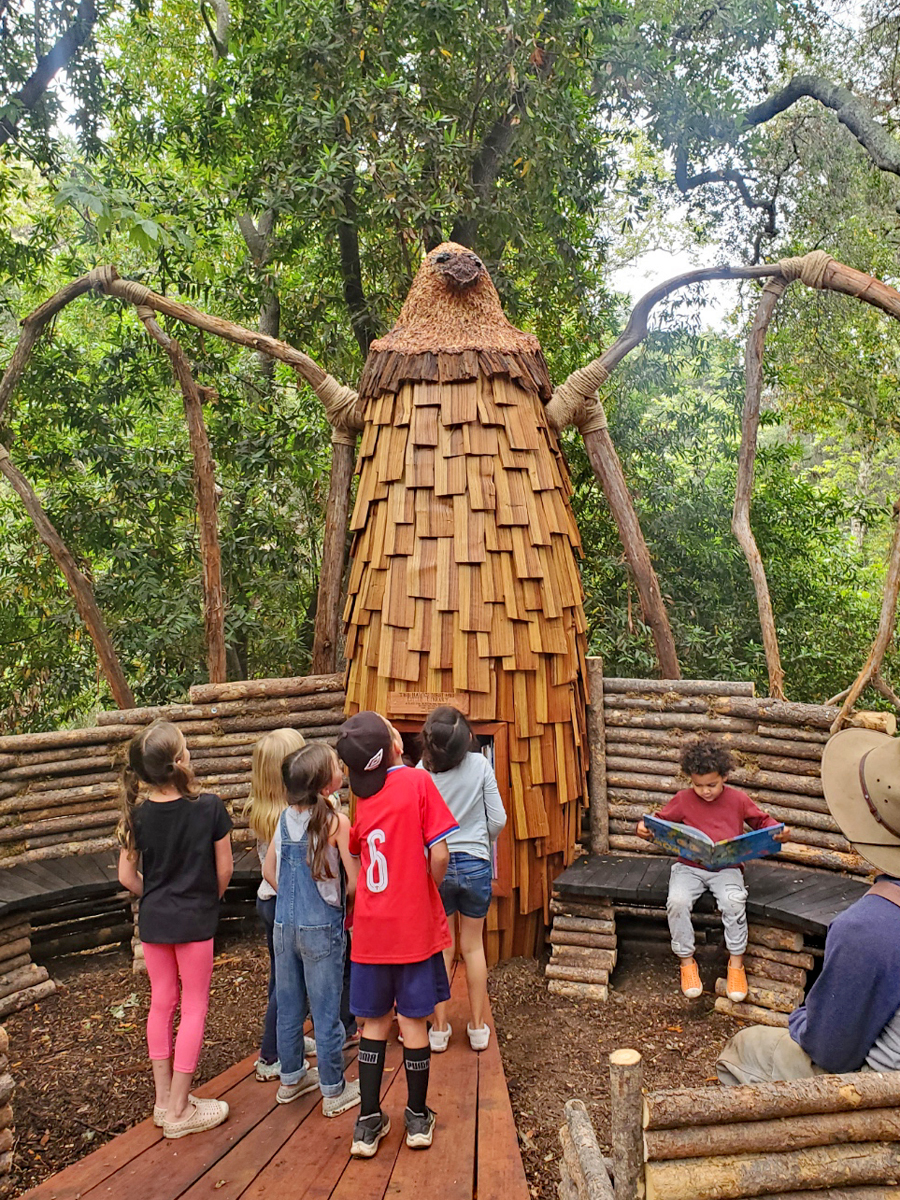
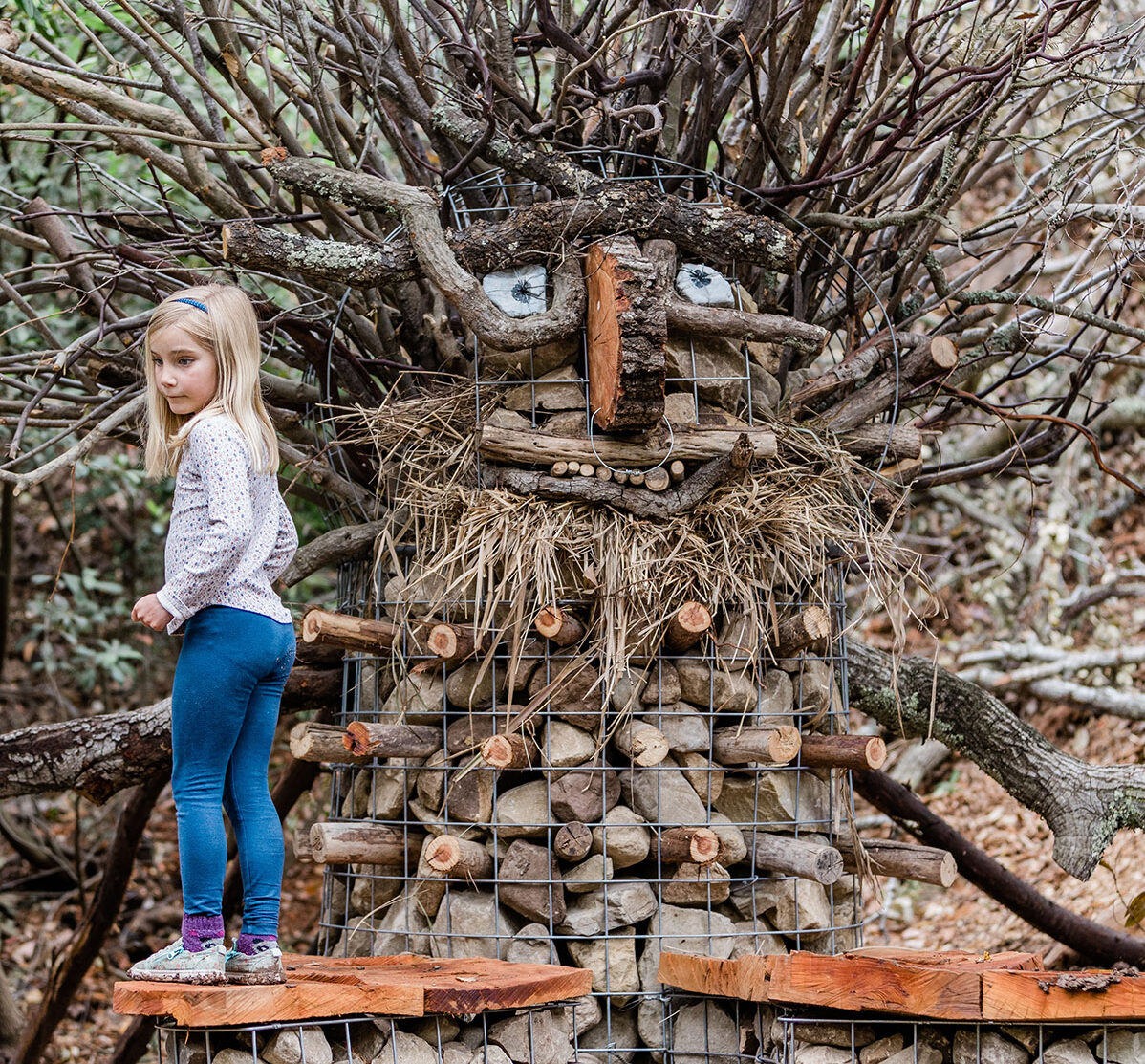
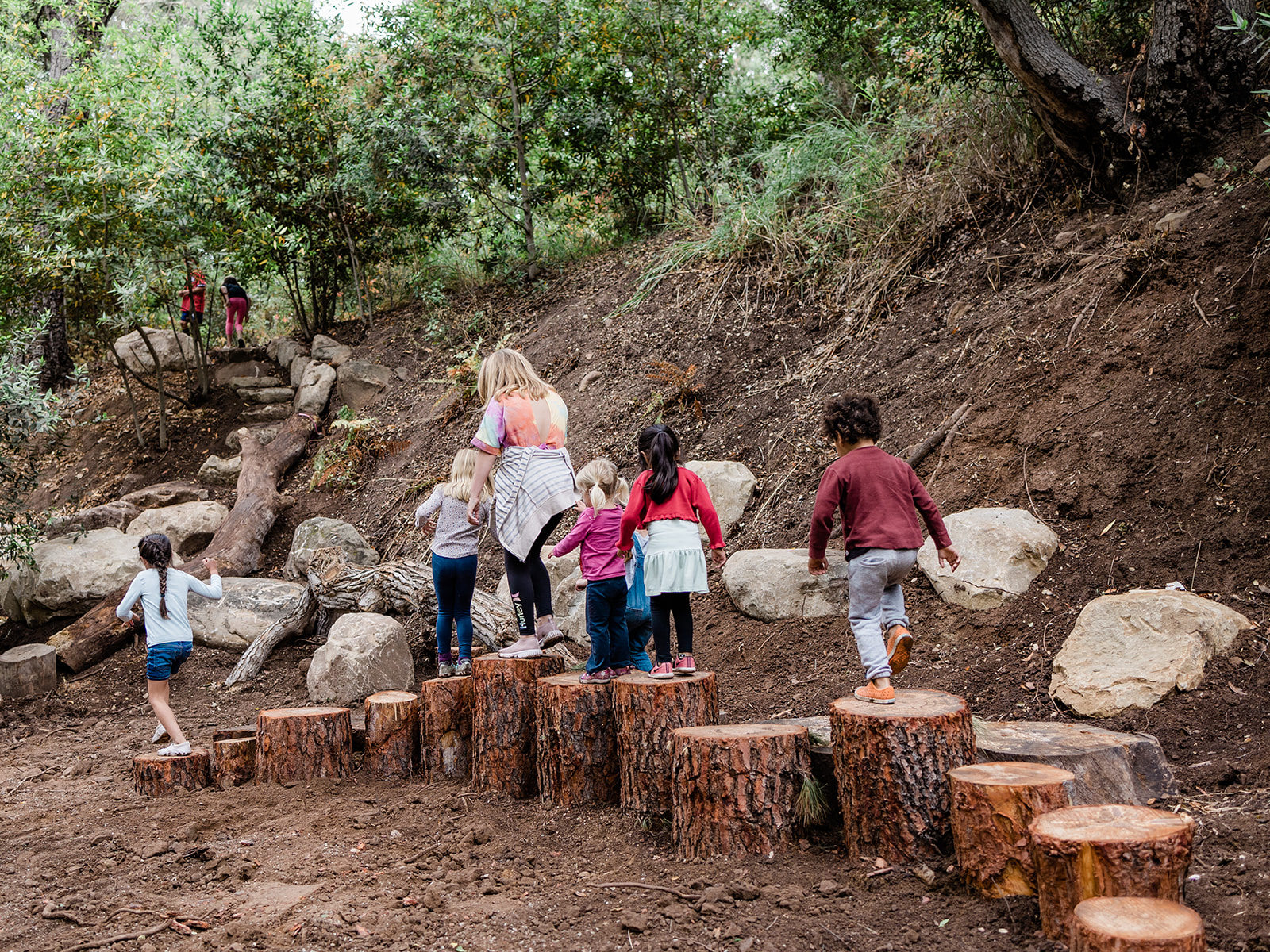
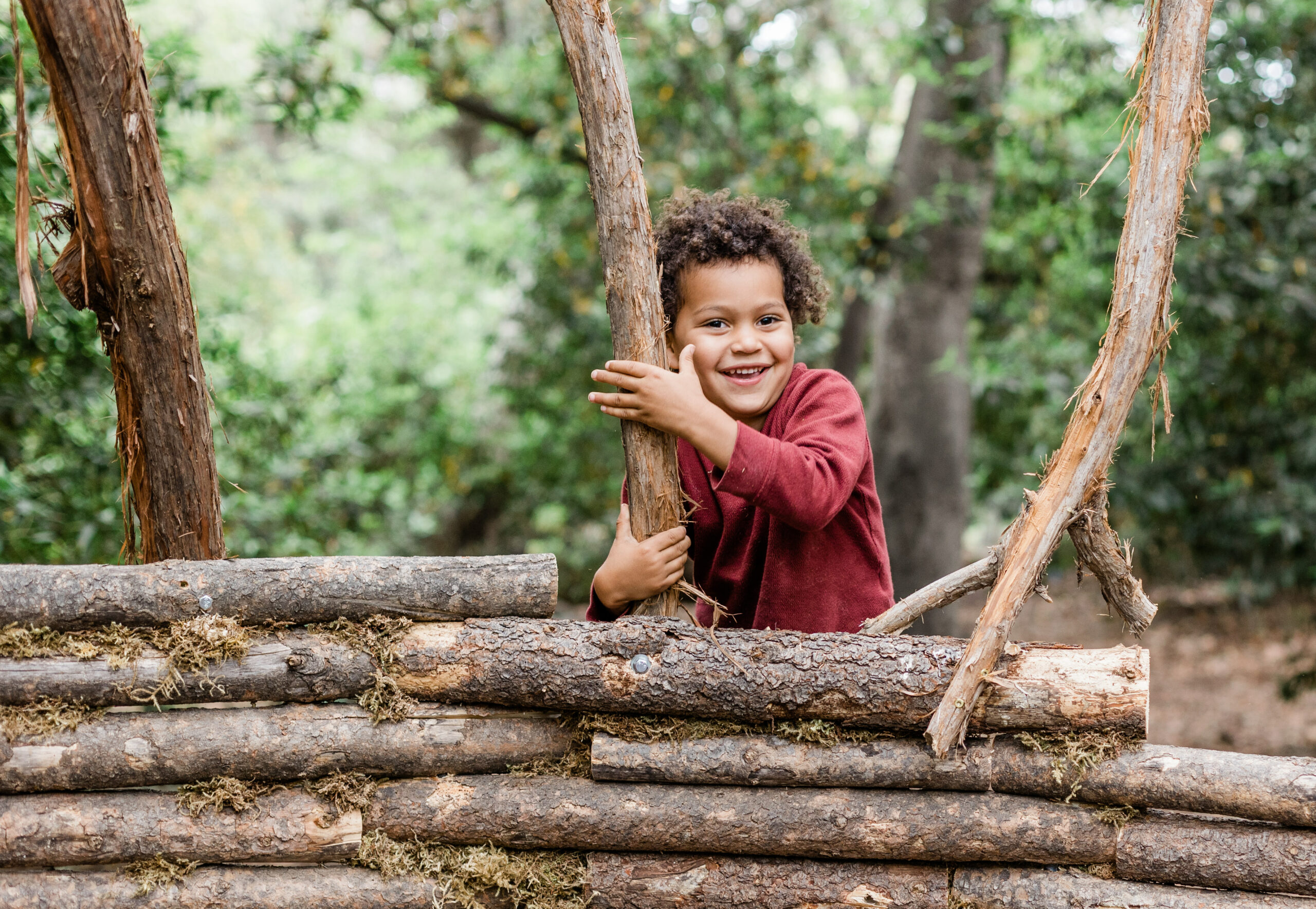
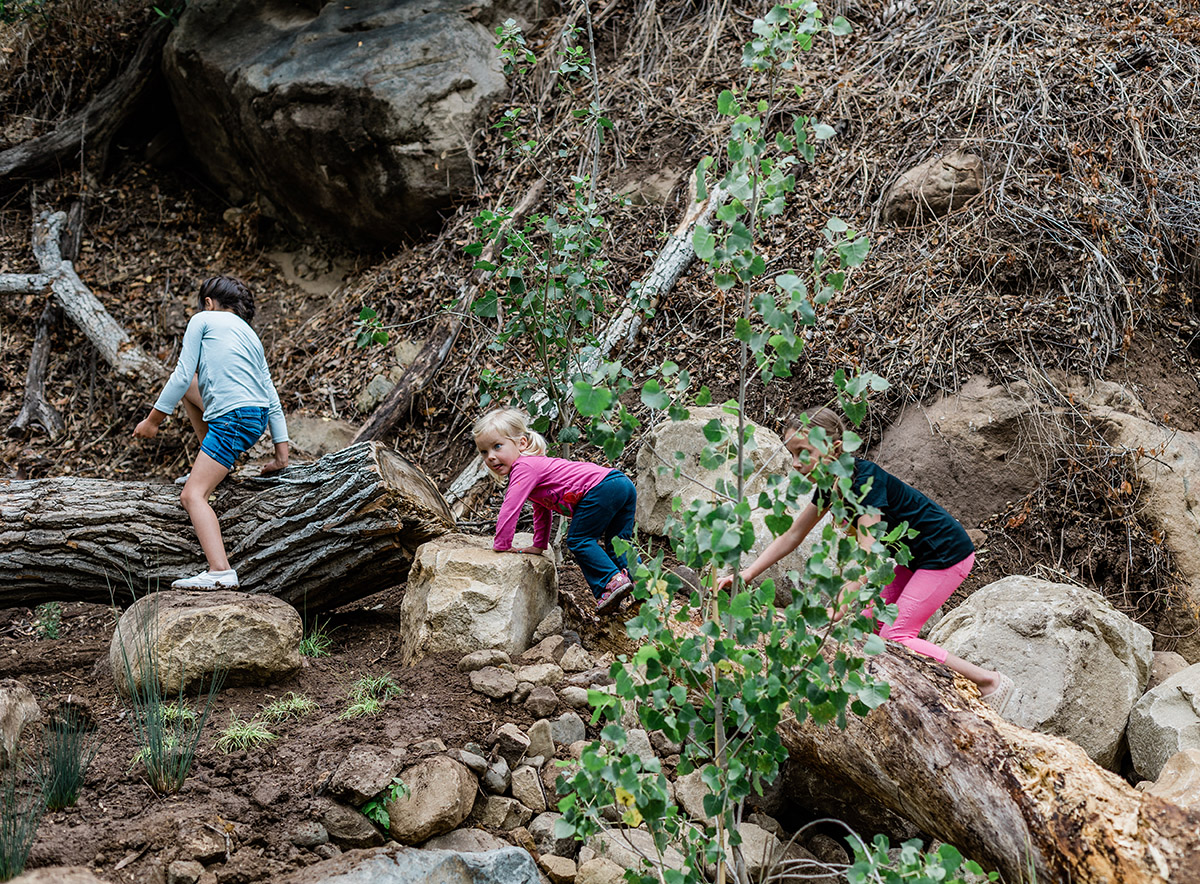
Acerca de las Casitas de Campo
Inspirado en los cuentos míticos de las criaturas del bosque, un gran troll domina el arroyo Mission Creek, cerca de la entrada del Backcountry. Se construyó utilizando una malla metálica rellena de piedras (llamadas cestas de gaviones) y ramas de árboles autóctonos. Trolling Trees fue diseñado por Natalie Leyva, estudiante de arquitectura paisajística de la Universidad Estatal de Colorado.
Un halcón de cola roja de 3 metros de altura despliega sus "alas" de madera para crear una zona de asientos semicircular para que los niños se tomen un tranquilo respiro. Hay libros sobre la naturaleza en una "pequeña biblioteca" dentro del torso del halcón. Cerca, los niños pueden construir sus propios nidos de palos. El Nido de Halcón fue creado por el diseñador y constructor de Santa Bárbara Cody Westheimer y se encuentra cerca del Basecamp.
El Árbol Gaia del Central Coast Green Building Council es, literalmente, una "casa en el árbol": una caprichosa estructura dentro de un árbol hueco, situada cerca del Upper Rock Crossing. Los materiales ecológicos incluyen roble recuperado para las ramas, chatarra recuperada para las hojas y cob (mezcla de arcilla, arena y paja).
Situado en la ladera del punto más alto de Backcountry, The Perch ofrece una vista de pájaro de Basecamp y Mission Creek. Este elemento ofrece una vista de pájaro de la región que rodea a Basecamp y permite a los visitantes trepar por una red de cuerdas para llegar a una "percha" de troncos de roble derribados. Fue creado por Brightview Design Group de Irvine, California, la empresa que se encargó del resto de los elementos de diseño y construcción del Backcountry.
En Quail Grove, los niños pueden simular ser abejas mientras exploran una colmena a escala humana construida con troncos, algunos de los cuales están huecos para que los niños trepen por ellos, imitando los hogares de las abejas nativas de California que anidan en cavidades. La diseñadora de Be a Bee es Kelly Curl, profesora asociada de arquitectura paisajística en la Universidad Estatal de Colorado.
# # #
Acerca del Jardín Botánico de Santa Bárbara: El Jardín Botánico de Santa Bárbara es el primer jardín botánico del país dedicado exclusivamente a las plantas autóctonas y lleva casi un siglo trabajando para comprender mejor la relación entre las plantas y las personas. El recinto, que pasó de tener 13 acres en 1926 a los 78 actuales, incluye ahora más de 8 kilómetros de senderos, un herbario, un banco de semillas, laboratorios de investigación, una biblioteca y un vivero público de plantas autóctonas. En medio de la serena belleza del Jardín, los equipos de científicos, educadores y horticultores siguen comprometidos con el espíritu original de los fundadores de la organización: conservar las plantas y los hábitats autóctonos de la CA para garantizar que sigan sustentando la vida en el planeta y puedan ser disfrutados por las generaciones venideras.
 Donar
Donar